I couldn’t wait for my third yoga teacher training weekend to arrive. On the agenda were three of my favorite things: philosophy, twists, and backbends.
Wheel Pose
All About Backbends
Backbends are some of my favorite yoga poses to do. Working at the computer can have some bad effects on posture, and backbends are basically the ultimate countermovement to what many of us do on a daily basis.
Of course, that also means there’s a certain risk factor involved. At our training we learned three key points to safe backbending, be it in a yoga practice or just for mobility purposes.
RELATED: A Bodyweight Exercise to Prevent Back Pain and Shoulder Pain
1. Warm Up Properly
Our teacher for the first part of the weekend, Libby, put it perfectly: To warm up for big backbends, do smaller backbends. I’ve been in several classes that have gone straight into full wheel without a lot of warm up. Here are some smaller backbends to do before you jump into the fullest expression of the backbend:
1. Child’s Pose to Kneeling
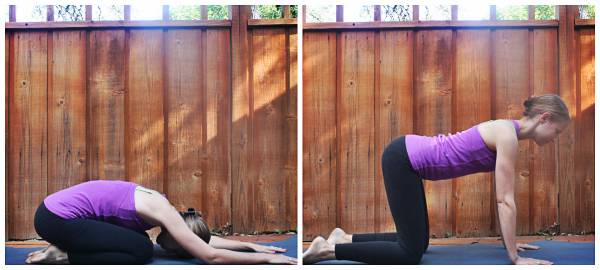
When you move from child’s pose to kneeling, pull your body forward with your hands to slightly accentuate the lumbar curve in the spine.
2. Cobra

3. Upward Dog
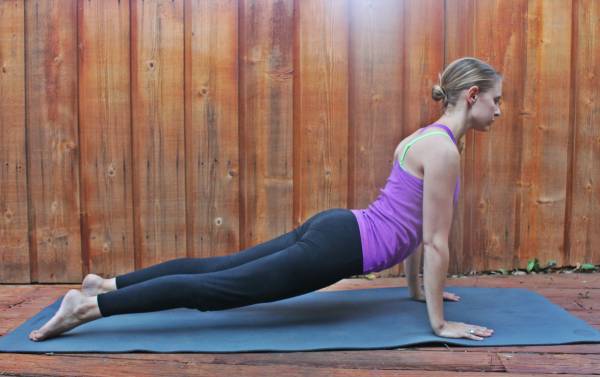
4. Bridge Pose
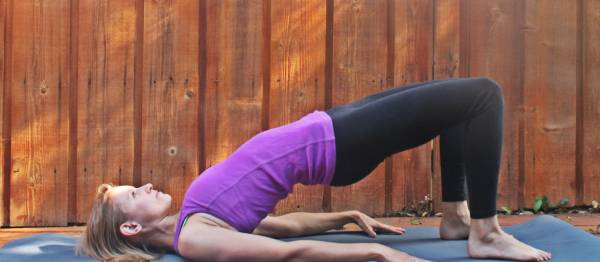
2. Don’t Forget Counterposes
One of the things I’m enjoying most in my yoga training is learning how to sequence. As you warm up with smaller backbends, add in forward bends to bring balance to the sequence. When you think of forward bends, that can be any pose that fully extends the spine, be it a forward fold or downward dog.
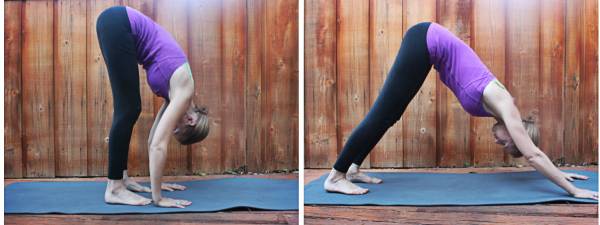
Left: Forward Fold; Right: Downward Dog
3. Don’t Rush Out of It
Once you come out of a full backbend like bow or wheel, it might seem like a forward fold would be the right thing to do, since it is a counterpose after all. However, seeing as you’ve just brought your spine to one extreme direction with a full backbend, going straight into full axial extension is unwise. Instead, ease of of bow pose with some smaller backbends, like bridge pose, then slowly work your way into a forward fold like child’s pose or downward facing dog.
“Axial extension manifests itself differently in each body and in each asana. We need to tune in to both as yoga teachers.”
Here’s an example of a sequence you could do that includes lots of counterposes and eases you in and out of wheel pose. I have put all the forward bends in italics.
- Child’s Pose to Kneeling
- Downward Dog
- Cobra
- Child’s Pose
- Downward Dog
- Plank Pose, lower to
- Upward Facing Dog
- Child’s Pose
- Mountain Pose
- Forward Fold
- Upward Salute
- Mountain Pose
- Warrior I (Right)
- Mountain
- Warrior 1 (Left)
- Mountain
- Forward Fold
- Downward Dog
- Child’s Pose – then roll over to your back
- Bridge Pose
- Knees to Chest
- Bridge Pose with hands interlaced under your back
- Knees to Chest
- Full Wheel Pose
- Bridge Pose
- Knees to Chest
- Happy Baby
- Roll to your side and press up to seated
- Child’s Pose
All these things probably seem simple and intuitive, because they are. However, in my previous experience in dance and many public yoga classes, the importance of protecting the spine during backbends isn’t always emphasized. It was refreshing to get a new perspective.
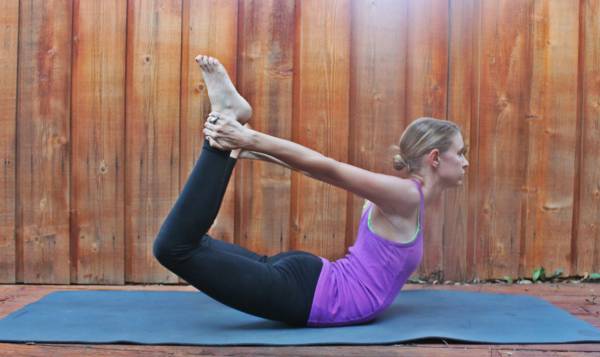
Bow Pose
Fourteen Yoga Lessons
At the end of the weekend, our teacher Eduardo, who did an amazing session on spinal twists and breathing, asked each person in the class to share one important lesson they had learned so far in our training. I wrote the lessons down in my notebook and have boiled them down to the following fourteen:
- The philosophy and sutras of Patanjali. We spent a whole day on Saturday reading through the first part of the sutras.
- Yoga was originally meant for teenage boys (no wonder it’s hard to get into some of those poses!).
- Why we are in the training to begin with – for ourselves, and to learn how to help others.
- It’s okay not to be normal.
- Anatomy is pretty fascinating and much more interesting than it was in high school.
- Identifying the foundation, motion, and action of each pose in order to guide sequencing more effectively.
- Axial extension manifests itself differently in each body and in each asana. We need to tune in to both as yoga teachers.
- The yoga sutras are amazing and full of wisdom.
- I know nothing at all about yoga. Yoga means a lifetime of learning.
- Yoga builds community. Just a few months ago everyone in my class was a stranger, and now I consider them friends.
- It’s hard to talk someone through a yoga pose. Really hard.
- There are more body parts than we all ever realized, even the nurses in the group.
- Understanding anatomy can help us control daily stresses in life.
- Asana is only one small portion of yoga. There are many more facets and a rich, vibrant history full of wisdom, that extends far beyond even the yoga of Patanjali.
Until next time, here are some words to ponder as you make your way through the twists and bends of daily life: “Before enlightenment, chop wood, carry water. After enlightenment, chop wood, carry water.”






